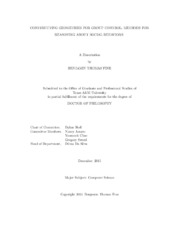| dc.description.abstract | Social behaviors in groups has been the subjects of hundreds of studies in a variety of research disciplines, including biology, physics, and robotics. In particular, flocking behaviors (commonly exhibited by birds and fish) are widely considered archetypical social behavioris and are due, in part, to the local interactions among the individuals and the environment. Despite a large number of investigations and a significant fraction of these providing algorithmic descriptions of flocking models, incompleteness and imprecision are readily identifiable in these algorithms, algorithmic input, and validation of the models. This has led to a limited understanding of the group level behaviors. Through two case-studies and a detailed meta-study of the literature, this dissertation shows that study of the individual behaviors are not adequate for understanding the behaviors displayed by the group.
To highlight the limitations in only studying the individuals, this dissertation introduces a set of tools, that together, unify many of the existing microscopic approaches. A meta-study of the literature using these tools reveal that there are many small differences and ambiguities in the flocking scenarios being studied by different researchers and domains; unfortunately, these differences are of considerable significance. To address this issue, this dissertation exploits the predictable nature of the group’s behaviors in order to control the given group and thus hope to gain a fuller understanding of the collective.
From the current literature, it is clear the environment is an important determinant in the resulting collective behaviors. This dissertation presents a method for reasoning about the effects the geometry of an environment has on individuals that exhibit collective behaviors in order to control them. This work formalizes the problem of controlling such groups by means of changing the environment in which the group operates and shows this problem to be PSPACE-Hard. A general methodology and basic framework is presented to address this problem. The proposed approach is general in that it is agnostic to the individual’s behaviors and geometric representations of the environment; allowing for a large variety in groups, desired behaviors, and environmental constraints to be considered. The results from both the simulations and over 80 robot trials show (1) the solution can automatically generate environments for reliably controlling various groups and (2) the solution can apply to other application domains; such as multi-agent formation planning for shepherding and piloting applications. | en |


